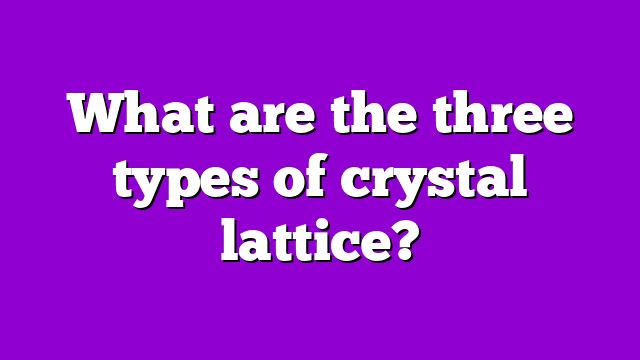Crystal Structures & Grids
What are the three types of crystal lattice?
There are three types of crystal lattice: primitive, face-centered, and body-centered. The lattice is the underlying structure of a crystal, while the crystal is the three-dimensional, visually observable manifestation of the lattice. Here are the key distinctions between lattice and crystal:
• Lattice: The arrangement of atoms, molecules, or ions that make up the crystal.
• Crystal: The visible, physical expression of the underlying lattice structure.
• Primitive lattice: The simplest lattice structure, consisting of one unit cell with atoms positioned only at its corners.
• Face-centered lattice: A lattice structure in which atoms are positioned at the corners of the unit cell, as well as in the center of each of its faces.
• Body-centered lattice: A lattice structure in which atoms are positioned at the corners of the unit cell, as well as in the center of the cell itself.
Understanding crystal lattice structures is crucial to understanding the properties and behavior of crystals. Different lattices result in different crystal shapes and sizes, as well as unique physical and chemical properties.
Table Of Contents
Types of Crystal Lattice
There are three types of crystal lattice, which are classified based on their symmetry and geometric arrangement of atoms or molecules. These include:
1. Cubic Lattice: This type of lattice has a cube-like structure with atoms or molecules arranged in a regular pattern. It has three axes of equal length perpendicular to each other, and its symmetry is known as isotropic. This means that the properties of the crystal are the same in all directions. Examples of cubic lattices include sodium chloride and diamond.
2. Hexagonal Lattice: This type of lattice has a hexagon-shaped structure with six points of symmetry. The axis in this type of lattice is perpendicular to the hexagon’s plane, and the lattice itself is anisotropic. This means that the properties of the crystal are different in different directions. Examples of hexagonal lattices include graphite and quartz.
3. Orthorhombic Lattice: This type of lattice has a rectangular structure with three axes of unequal lengths that are perpendicular to each other. Its symmetry is anisotropic, and its properties vary along different axes. Examples of orthorhombic lattices include sulfur and barium titanate.
Definition of Crystal Lattice
A crystal lattice is a repeating, 3-dimensional pattern of atoms, ions, or molecules in a crystalline material. It forms the basic structure of a crystal, and it is responsible for the crystal’s physical and chemical properties such as its melting point, hardness, and conductivity. The atoms or molecules within the crystal lattice are held together by strong forces such as covalent, ionic, or metallic bonding.
Distinction between Lattice and Crystal
Although the terms lattice and crystal are often used interchangeably, there is a distinction between the two. A crystal lattice refers to the 3-dimensional repeating pattern of atoms within a crystal, while a crystal is a solid material with a definite shape and size that is composed of the crystal lattice and other components. In other words, a crystal is a physical object made up of the crystal lattice, whereas the crystal lattice is an abstract concept that describes the arrangement of atoms within the crystal.
Characteristics of Cubic Lattice
The cubic lattice is the most symmetrical of the three types of crystal lattice, and it has the following characteristics:
– Its atoms or molecules are arranged in a regular pattern that forms a cube-like structure with three axes of equal length.
– Its symmetry is isotropic, which means that its properties are the same in all directions.
– Examples of cubic lattices include sodium chloride and diamond.
– It has a high degree of symmetry and is often used in studies of crystal structure.
Characteristics of Hexagonal Lattice
The hexagonal lattice has a unique hexagon-shaped structure and the following characteristics:
– It has six points of symmetry and an axis perpendicular to the hexagon’s plane.
– Its symmetry is anisotropic, which means that its properties vary in different directions.
– Examples of hexagonal lattices include graphite and quartz.
– It has unique optical and electrical properties and is used in electronic and optical devices.
Characteristics of Orthorhombic Lattice
The orthorhombic lattice has a rectangular structure and the following characteristics:
– It has three axes of unequal length that are perpendicular to each other.
– Its symmetry is anisotropic, which means that its properties vary in different directions.
– Examples of orthorhombic lattices include sulfur and barium titanate.
– It has unique mechanical, electrical, and magnetic properties and is used in engineering and materials science.
Uses of Crystal Lattice in Science and Technology
Crystal lattices are used in various scientific and technological applications due to their unique physical and chemical properties. Some of these applications include:
– Materials Science: The study of crystal lattices is important in materials science, as it helps researchers understand the structure and properties of materials. This knowledge can be used to develop new materials with specific properties, such as superconductors or high-strength alloys.
– Electronics: Crystal lattices are used in electronic devices such as transistors, diodes, and solar cells. The unique electrical properties of some crystal lattices, such as the piezoelectric effect in quartz, make them useful in electronic devices that convert mechanical energy to electrical energy and vice versa.
– Medicine: Some crystal lattices have unique chemical properties that make them useful in medicine. For example, the crystal lattice of insulin plays a critical role in its stability and activity, making it essential for the treatment of diabetes.
In conclusion, crystal lattices are the basis of the physical and chemical properties of crystalline materials, and their unique structures and symmetries have made them useful in various scientific and technological applications. The three types of crystal lattice discussed in this article, cubic, hexagonal, and orthorhombic, have distinct properties and applications in different fields of study.

